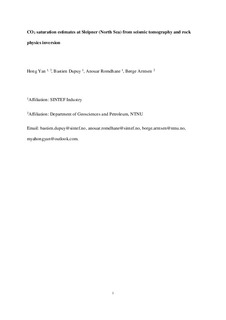| dc.contributor.author | Yan, Hong | |
| dc.contributor.author | Dupuy, Bastien | |
| dc.contributor.author | Romdhane, Mohamed Anouar | |
| dc.contributor.author | Arntsen, Børge | |
| dc.date.accessioned | 2019-06-06T13:45:36Z | |
| dc.date.available | 2019-06-06T13:45:36Z | |
| dc.date.created | 2018-10-04T13:54:32Z | |
| dc.date.issued | 2018 | |
| dc.identifier.issn | 0016-8025 | |
| dc.identifier.uri | http://hdl.handle.net/11250/2600207 | |
| dc.description.abstract | CO2 saturations are estimated at Sleipner using a two‐step imaging workflow. The workflow combines seismic tomography (full‐waveform inversion) and rock physics inversion and is applied to a two‐dimensional seismic line located near the injection point at Sleipner. We use baseline data (1994 vintage, before CO2 injection) and monitor data that was acquired after 12 years of CO2 injection (2008 vintage). P‐wave velocity models are generated using the Full waveform inversion technology and then, we invert selected rock physics parameters using an rock physics inversion methodology. Full waveform inversion provides high‐resolution P‐wave velocity models both for baseline and monitor data. The physical relations between rock physics properties and acoustic wave velocities in the Utsira unconsolidated sandstone (reservoir formation) are defined using a dynamic rock physics model based on well‐known Biot–Gassmann theories. For data prior to injection, rock frame properties (porosity, bulk and shear dry moduli) are estimated using rock physics inversion that allows deriving physically consistent properties with related uncertainty. We show that the uncertainty related to limited input data (only P‐wave velocity) is not an issue because the mean values of parameters are correct. These rock frame properties are then used as a priori constraint in the monitor case. For monitor data, the Full waveform inversion results show nicely resolved thin layers of CO2–brine saturated sandstones under intra‐reservoir shale layers. The CO2 saturation estimation is carried out by plugging an effective fluid phase in the rock physics model. Calculating the effective fluid bulk modulus of the brine–CO2 mixture (using Brie equation in our study) is shown to be the key factor to link P‐wave velocity to CO2 saturation. The inversion tests are done with several values of Brie/patchiness exponent and show that the CO2 saturation estimates are varying between 0.30 and 0.90 depending on the rock physics model and the location in the reservoir. The uncertainty in CO2 saturation estimation is usually lower than 0.20. When the patchiness exponent is considered as unknown, the inversion is less constrained and we end up with values of exponent varying between 5 and 20 and up to 33 in specific reservoir areas. These estimations tend to show that the CO2–brine mixing is between uniform and patchy mixing and variable throughout the reservoir. | nb_NO |
| dc.language.iso | eng | nb_NO |
| dc.publisher | Wiley | nb_NO |
| dc.title | CO2 saturation estimates at Sleipner (North Sea) from seismic tomography and rock physics inversion | nb_NO |
| dc.type | Journal article | nb_NO |
| dc.type | Peer reviewed | nb_NO |
| dc.description.version | acceptedVersion | nb_NO |
| dc.source.journal | Geophysical Prospecting | nb_NO |
| dc.identifier.doi | 10.1111/1365-2478.12693 | |
| dc.identifier.cristin | 1617970 | |
| dc.relation.project | Norges forskningsråd: 257579 | nb_NO |
| dc.relation.project | Norges forskningsråd: 233716 | nb_NO |
| dc.description.localcode | Locked until 9.10.2019 due to copyright restrictions. This is the peer reviewed version of an article, which has been published in final form at [https://doi.org/10.1111/1365-2478.12693]. This article may be used for non-commercial purposes in accordance with Wiley Terms and Conditions for Self-Archiving. | nb_NO |
| cristin.unitcode | 194,64,90,0 | |
| cristin.unitname | Institutt for geovitenskap og petroleum | |
| cristin.ispublished | true | |
| cristin.fulltext | original | |
| cristin.qualitycode | 1 | |
